5 steps - How to choose the right voltage stabilizer for your home
There are many types of voltage regulators on the market today. These are electronic and electromechanical and hybrid and thyristor. But to say that some are better and others are worse would not be correct. Each of them has its own scope. It's like saying that a cargo Kamaz is worse than an urban business-class Mercedes. The first has its own scope, and the second has its own and cannot be replaced by one another. Kamaz is not suitable for delivering a businessman to a meeting, and you cannot bring 10 tons of cargo on a Mercedes. But on the contrary - Kamaz will easily transport 10 tons of sand, and Mercedes will comfortably deliver a businessman to a meeting.
So it is with voltage stabilizers. For example, relay stabilizers can work quietly even at sub-zero temperatures (down to -30°C), but is this ability necessary if they are installed inside a heated house? No.
But for summer cottages, the ability of relays to work at temperatures below zero is very useful.
Therefore, for a private house in stabilizers, such qualities as smooth adjustment(so that the lights do not blink) and how accurate is the output voltage.
Voltage stabilizer for home how to choose
Smooth voltage regulation is the main feature electromechanical voltage stabilizers. Inside they have a copper winding, along which a brush travels with the help of a servo. When the voltage in the mains changes, the servo drive moves the brush along the winding, thereby smoothly equalizing the voltage. In addition, this adjustment method allows you to maintain a very high voltage accuracy at the output of the stabilizer (220V ± 3%), which is also important when used with home video and audio equipment.
But classic electromechanical stabilizers always had one very important drawback - this is a rather narrow input voltage range (up to 140V). This means that when the voltage in the mains drops below 140 volts, the electromechanical stabilizer simply turns off and de-energizes all electrical appliances in the house.
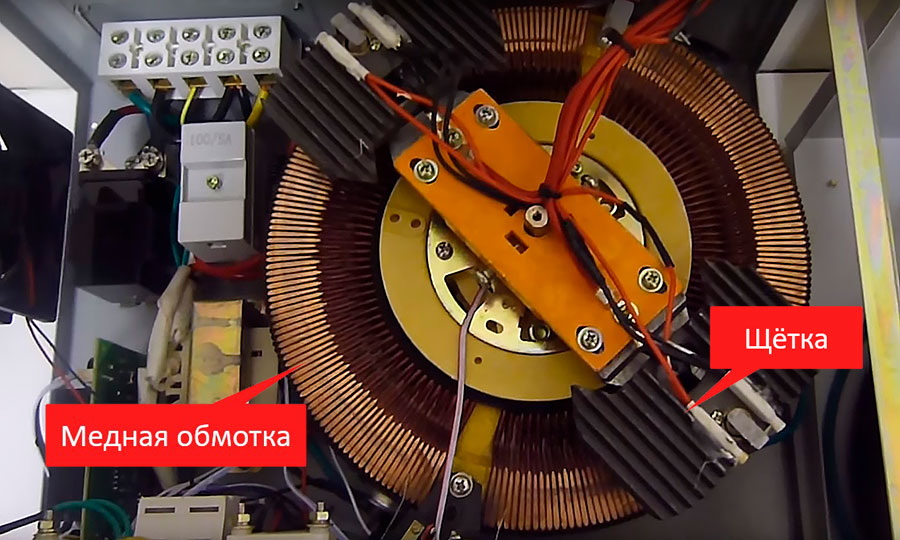
The design of the electromechanical stabilizer
To overcome this shortcoming, the so-called hybrid voltage stabilizers capable of leveling the voltage in the range of 105V ... 280V. They got their name due to the design features. Inside the hybrids, in fact, there are 2 modules - electromechanical and relay. The main mode of operation of hybrids is electromechanical (active when the input voltage changes in the range from 140V to 280V), with smooth and high-precision equalization of all fluctuations in the electrical network. But when the voltage drops below 140 volts, the protective shutdown no longer works, but instead a relay unit is connected, which is able to draw drawdowns up to 105V.
Advantages of hybrid stabilizers:
- smooth adjustment (light bulbs will not blink);
- very accurate - hold 220V (± 3%);
- equalize the voltage with 105V.
The disadvantages include:
- floor version- cannot be hung on the wall. Although with the help of a special rack you can install them one above the other;
- can only work at temperatures above 0°C.
magazin energy en
In addition to hybrid devices for the home, they also put thyristor Surge Protectors. The role of the power key in them is performed by a semiconductor element, a thyristor. Thanks to this, it is possible to further expand the input voltage range and draw drawdowns up to 60V!
Due to the absence of moving parts, thyristor stabilizers do not create absolutely no noise during operation. This makes it possible to use them even inside urban apartments. In addition, thyristor devices are considered the most durable among voltage stabilizers. Because of this, manufacturers often give extended warranties on them.
Advantages of thyristor stabilizers:
- cope even with an abnormal voltage drop up to 60V;
- absolutely silent (noise level - 0 dB);
- adjustment is carried out smoothly;
- high-precision - at the output we get 220V ± 5% (and 220 ± 3% for frost-resistant modifications)
- high response speed (20ms);
- made in a hinged design (do not take up much space and are conveniently mounted on the wall);
- have an extended 3 year warranty.
Flaws
- the technology for the production of thyristor stabilizers is quite expensive, so the price tag of the devices does not allow them to be installed in every home.
First rule:
For the house, you need to install a voltage regulator with smooth adjustment (so that the bulbs do not blink). These requirements fit: electromechanical (hybrid) or thyristor stabilizers.
Step #2 - Single-Phase or Three-Phase?
So, we decided on the type of stabilizer - we need an electromechanical / hybrid or thyristor device.
Now you need to understand whether to install single-phase (at 220V) or three-phase (at 380V)?
There are two options here:
- if one phase is connected to the house, then we select a single-phase stabilizer;
- it would seem that for a three-phase network there should be the same logical conclusion - for three phases, take a three-phase. But there is one caveat.
All three-phase stabilizers are designed in such a way that when one of the phases disappears, the protection works in the stabilizer and it turns off, de-energizing the whole house. Therefore, only if there are three-phase consumers in the house, we install a three-phase stabilizer.
If consumers are only at 220V, then it is better to put 3 single-phase voltage stabilizers (one for each phase). Most often, such a solution will even be cheaper in terms of money.
What to do if you do not know how many phases are connected to the house?
The most common answer to this question is: "If you had three phases, you would know about it." Indeed, most of the private houses of the old building have one phase and all household consumers are designed for 220V (TV, refrigerator, computer, video and audio equipment).
Three phases are often brought to modern country cottages, because. in addition to household electrical appliances, it is planned to install three-phase consumers at 380V.
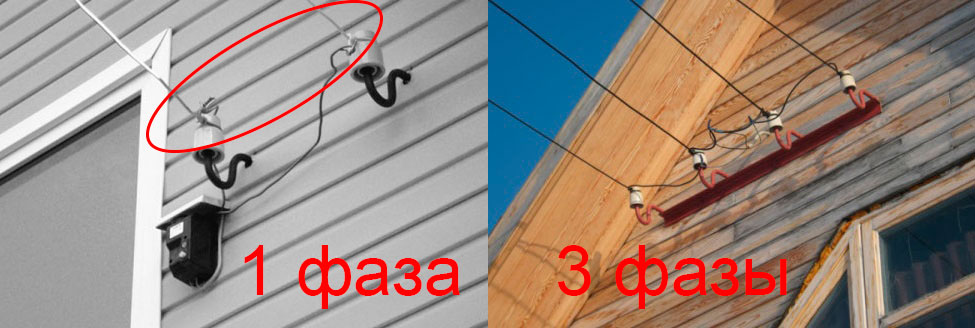
2 or 3 wires are connected to the house - a single-phase network, 4 or more - a three-phase network.
Second rule:
If one phase is connected to the house, we stop at single-phase stabilizers.
For a three-phase network:
- if there are consumers at 380V - we put one three-phase stabilizer;
- if consumers are only for 220V - we put 3 single-phase stabilizers (one for each phase).
Step #3 - Should it work in sub-zero temperatures?
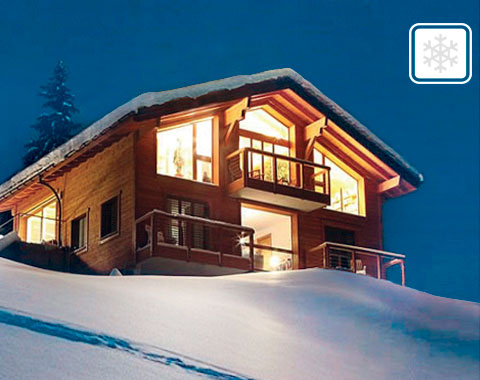
So, now we know that, depending on consumers, it is necessary to install single-phase or three-phase apparatus.
The next step is simple - will there be a stabilizer in a heated room or not. Most often, the device is located in a technical room inside the house and there is no need for frost-resistant devices.
If you suddenly need to work at temperatures below zero, then remember this parameter in the stabilizer as important.
Third rule:
Most often, stabilizers are placed inside the house and there are no requirements for frost resistance. But if it will stand in an unheated room, then we choose among stabilizers capable of operating at sub-zero temperatures.
Step #4 - How much power do you need a stabilizer?
At the previous stages, we learned that a device with smooth adjustment is needed for the house, we decided on the number of phases of the necessary device (single-phase or three-phase) and decided for ourselves whether it will stand in a heated room or a frost-resistant version is needed.
Now you need to understand how much power the device should have.
This issue must be taken carefully, since taking a low power stabilizer, as a result, we will get frequent shutdowns of the stabilizer due to overload.
The basic rule that is usually followed when choosing a voltage stabilizer for the home is as follows:
An introductory machine is installed on each private house or country cottage, which does not allow loading the house's electrical wiring more than it is designed for. This is not due to the "greed" of electricians, as if they do not want to allow the owner of the house to turn on appliances with more power than allowed. The reason is simple - to prevent a fire. In order to prevent overheating of the wires and the occurrence of a fire due to this, an introductory machine is installed. If a person tries to simultaneously load the electrical wiring with devices with more power than allowed, the introductory machine will perform a protective shutdown and prevent a fire in the house.
Most often, such introductory machines are placed at home:

Introductory machine for 40 A (amps)
In order to find out how much power a voltage stabilizer is needed for our house, the same formula is always applied:
- Option number 1 - a single-phase 220V network is connected to the house
In this case, we multiply the value of the introductory machine (we have 40 amperes) by 220 volts:
40 * 220 = 8 800
It turns out that for our house we need a stabilizer with a power of at least 8800 VA (volt-amperes) or 8.8 kVA (kilovolt-amperes).Knowing the typical line of power stabilizers:
5, 8, 10, 15, 20, 30 kVAWe understand that a stabilizer for 8 kVA will no longer be able to cope with our load, but for 10 kVA - that's it.
- Option number 2 - a three-phase network for 380V is connected to the house
In the case of a three-phase network, the solution is as follows:- if there are 380V consumers at home- we put one three-phase stabilizer.
Its power is calculated as follows:
An introductory machine for private houses with a three-phase connection, most often at 20 amperes.
We multiply 20 amperes by 200V and multiply the resulting figure by another 3:
20 * 220 * 3 = 13 200
It turns out that the house needs a three-phase stabilizer with a power of at least 13200 VA (volt-ampere) or 13.2 kVA. (kilovolt-ampere).
Again, we take into account the power line of three-phase stabilizers (9, 15, 20, 30 kVA), we understand that we need a 15 kVA stabilizer.
Total, you need a three-phase 15 kVA. - If 3 phases are connected to the house, and all electrical appliances are ordinary, designed for 220V and it is not planned to install three-phase consumers, then it will be more efficient to install three single-phase stabilizers (one for each phase). This is done for the reason that in the event of a power failure in one of the phases, the three-phase stabilizer will de-energize the entire house. When installing three single-phase stabilizers, this problem does not arise and electrical appliances continue to work on the remaining two phases.
Power is calculated as for a conventional single-phase stabilizer (described above), with the difference that not one, but three pieces are needed:
40 * 220 = 8 800
Total, you need 3 stabilizers of 10 kVA each.
- if there are 380V consumers at home- we put one three-phase stabilizer.
Fourth rule:
Depending on the number of connected phases:
- for a single-phase network (220V), most often they put a single-phase stabilizer at 10 kVA;
- for a three-phase network, either one three-phase 15 kVA stabilizer or three single-phase 10 kVA stabilizers are installed (one for each phase).
Step #5 - How much does the voltage drop?
In the previous 4 steps, we found out that the house requires a stabilizer with smooth and fine adjustment (electromechanical / hybrid or thyristor devices are suitable for this). We learned that with a single-phase network, a single-phase stabilizer is needed, and with a three-phase one, one three-phase or three single-phase (in which cases and which one is indicated in Step No. 2). At Step No. 3, we decided whether we need a frost-resistant device or whether it will stand inside the house, in a heated room. And at Step No. 4 we calculated the required power of the device.
And now we come to that small but very important point that 80% of people forget about when choosing a stabilizer.
In theory, everything is simple - I looked at the figure on the introductory machine, multiplied it by 220V, and a stabilizer is needed for such power. But for some reason they forget that when the voltage drops (when the outlet is not 220V, but already 170V, 140V and lower), the power that any stabilizer can produce also drops. And instead of the declared 10 kW (kilowatt), it already produces 8 or 7 kW. Thus, if the home network is fully loaded (at the same time, electrical appliances with a total power of 10 kW are turned on and working), then the stabilizer will not be able to provide them with this power and, in order to avoid overheating and failure, a protection will be triggered that will turn off both the stabilizer and all electrical appliances in the house.
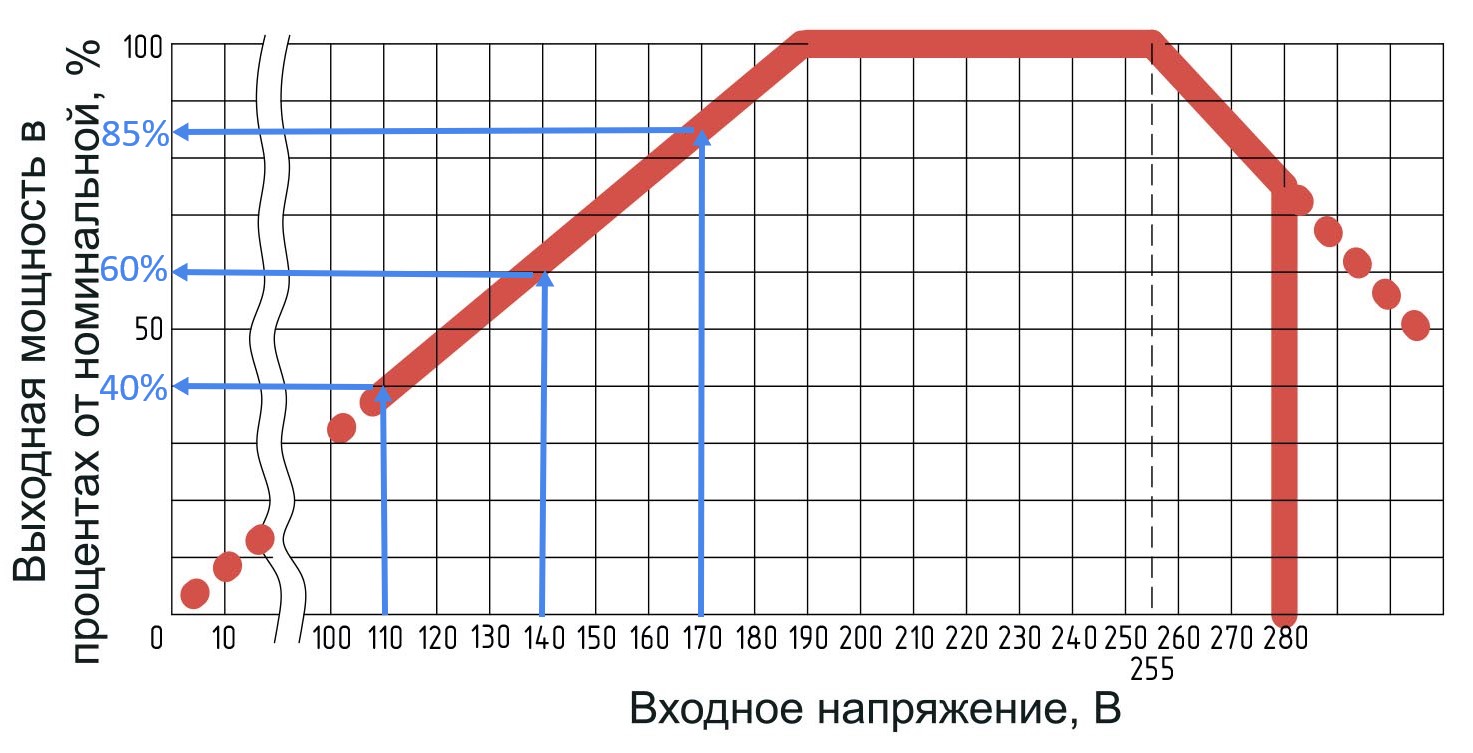
The dependence of the output power of the stabilizer on the voltage drop in the mains.
As you can see from the graph above, when the voltage drops to 170V, the stabilizer will be able to deliver a maximum of 85% of its power. If we take for example, a 10 kW apparatus, we get:
10 * 85 / 100 = total 8.5 kW
At a voltage of 140V, we have 65% of the power:
10 * 65 / 100 = total 6.5 kW
If our drawdowns reach 110V, then at the output we can only count on 40% of the power, and this is:
10 * 40 / 100 = only 4 kW
It is for this reason that all electricians unanimously advise taking a voltage regulator with a power margin of at least 30%.
The situation with increased voltage is not so common, but the power reserve must be taken in this case too:
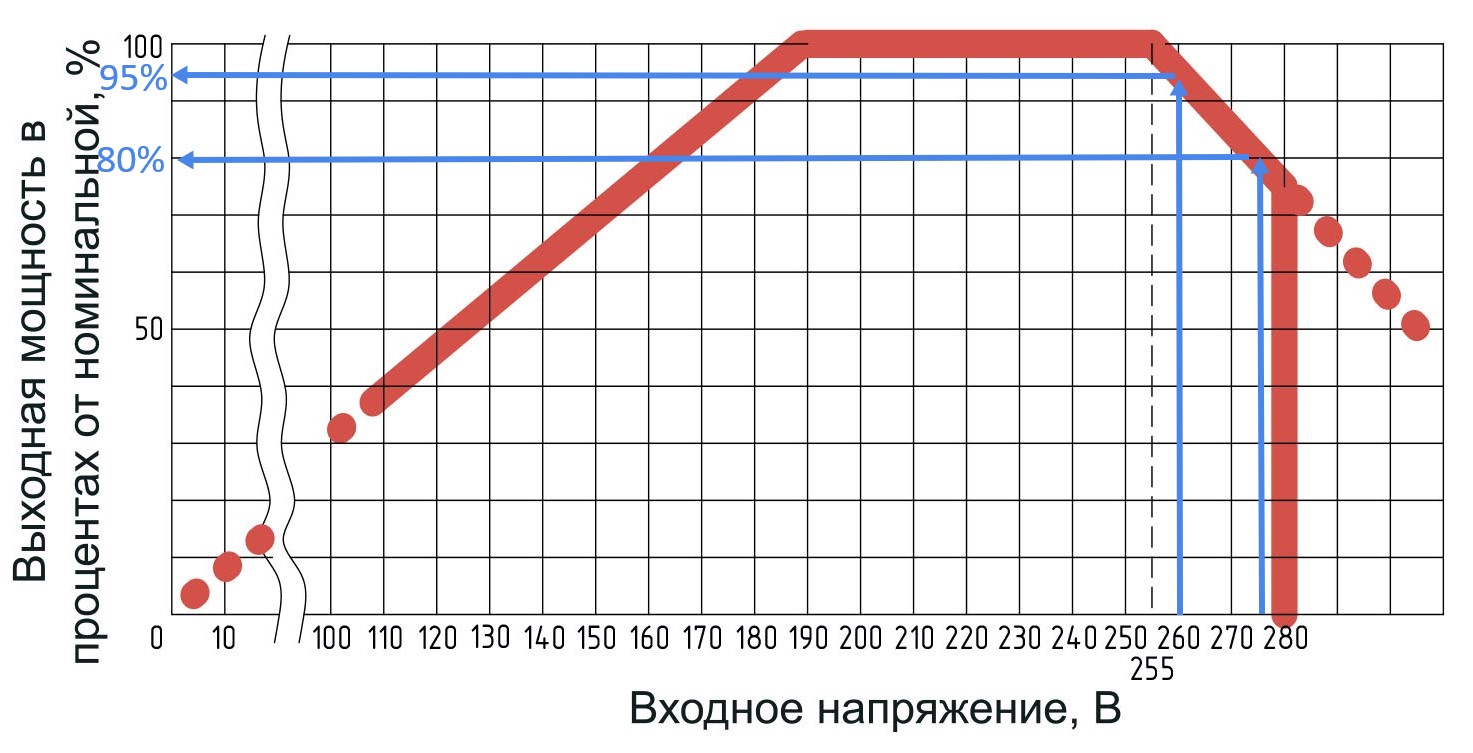
The dependence of the output power of the stabilizer at increased voltage.
Already at 255V, the stabilizer begins to lose power, and at 275V it is able to give out only 80% of the declared values. At 280V there is a protective shutdown.
Fifth rule:
With a low or high voltage, the power of any stabilizers drops. Therefore, you should always take the stabilizer "with a margin" in terms of power (at least 30%).
Conclusions:
So, today we learned that for the house:
- only accurate stabilizers with a small output error and smooth adjustment are suitable. This is necessary so that at the moment of equalizing the voltage, the bulbs do not blink and the electronics in the house work normally. Electromechanical, hybrid or thyristor devices are suitable for these requirements;
- decided whether you need a single-phase or three-phase device;
- we found out for ourselves whether it will stand in a heated room or a frost-resistant device is required;
- learned that for houses with one phase connected (at 220V), they most often take a 10 kVA (kilovolt-ampere) stabilizer, and for a three-phase network (at 380V), they choose devices for 15 kW (kilowatts). And they learned how to calculate the power of the required stabilizer individually for their home;
- remember that the stabilizer must be taken with a margin of power (at least 30%).
I hope I managed to help as much as possible with the selection of a stabilizer for the house. If you have learned something new for yourself and find this information useful, click on the social network buttons below and save this article for yourself so as not to lose it.
 Masonry mortars for brick kilns
Masonry mortars for brick kilns Why do the windows fog up in the apartment
Why do the windows fog up in the apartment Construction and schemes of brick ovens
Construction and schemes of brick ovens How to lay paving slabs: tips and tricks
How to lay paving slabs: tips and tricks How to drill bathroom tiles
How to drill bathroom tiles Monolithic slab on coarse soil
Monolithic slab on coarse soil Which electric heater is economical
Which electric heater is economical